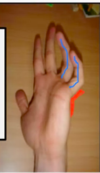Peripheral Lesions of the Upper Limb Flashcards
(52 cards)
What does the level of a lesion dictate?
Dictates the extent of the motor and / or sensory deficits and the appearance of the affected limb –> All muscles downstream of the lesion that have not already been innervated will be affected.
Which muscles are innervated by the radial nerve?
All posterior compartment muscles:
- Triceps
- All forearm extensors (extensors of wrist, fingers, thumb, APL)
- No muscles in the hand
What muscles are innervated by the median nerve?
- Almost all anterior forearm flexor muscles (except flexor carpi ulnaris and 1/2 flexor digitorum profundus)
- Thenar eminence (NOT adductor pollicis)
What muscles are innervated by the ulnar nerve?
- Almost all intrinsic hand muscles
- Apart from lateral 2 lumbricals
- 1 and 1/2 of anterior forearm muscles:
- 1/2 flexor digitorum profundus
- Flexor carpi ulnaris
What spinal nerves contribute to the radial nerve?
C5-T1
What skin is innervated by the radial nerve?
Skin over parts of the posterior arm, forearm, ASB and dorsolateral hand
What nerve is affected in ‘wrist drop’? Is the lesion typically high or low?
Caused by a a high radial nerve lesion; injury to the nerve most commonly happens in the mid arm (around humeral shaft)

How does a high radial nerve lesion cause ‘wrist drop’? What muscles does it affect? What are the sensory disturbances?
- Paralysis of forearm extensors (posterior compartment)
- Unable to extend the wrist, fingers and thumb
- Sensory loss over the lateral dorsum
Why can the elbow still be weakly extended in ‘wrist drop’?
By this point the radial nerve has usually sent a branch to the long head of the tricep –> can still weakly extend the elbow
What is the effect of a low radial nerve lesion?
Sensory deficit only –> radial nerve doesn’t innervate any muscles of the hand

Why does a low radial nerve lesion cause sensory deficit only?
Injury to superficial radial branch close to the wrist gives sensory deficit only –> superficial branch is sensory only as contributes to the cutaneous innervation of the dorsal hand and fingers.
Describe the difference between the deep and superficial branch of the radial nerve
The radial nerve terminates by dividing into two branches: deep and superficial
Deep: (motor) – innervates the muscles in the posterior compartment of the forearm.
Superifical: (sensory) – contributes to the cutaneous innervation of the dorsal hand and fingers.
What spinal nerves does the median nerve carry fibres from?
C5-T1
What muscles does the median nerve innervate?
Arm: none
Forearm:
- Pronator teres, palmaris longus, flexor carpi radialis (superifical layer)
- Flexor digitorum superficialis (middle layer)
- Lateral half of flexor digitorum profundus, pronator quadratus, flexor pollicis longus (deep layer)
- Via anterior interosseous branch
Hand:
- Thenar eminence (via recurrent branch)
- Lateral 2 lumbricals (via palmar digital branch)
What is the sensory innervation of the median nerve?
Skin over lateral 1/2 of the palm of the hand
Where would a high median nerve lesion be? Mid? Low?
High: Cubital fossa (elbow) area
Mid: Mid forearm
Low: Wrist

What condition does a high median nerve lesion cause?
‘Bishop’s hand’ / ‘Hand of Benediction’ / ‘pointing finger’

Describe the fingers in ‘Bishop’s hand’ / ‘Hand of Benediction’?
- Unable to flex 2nd and 3rd digits
- Also unable to fully straighten 2nd and 3rd digits
- Can fully flex and extend 4th and 5th digits
- Thenar weakness
When does ‘Bishop’s hand’ / ‘Hand of Benediction’ become evident?
When the patient tries to make a fist
Why are the 2nd and 3rd digits unable to be flexed in a high median lesion?
FDP (and FDS) to these fingers is weak/paralysed (median nerve innervation)
Why are the 2nd and 3rd digits unable to be fully straightened in a high median lesion?
The lumbricals to these 2 fingers are paralysed/weak
Why can the 4th and 5th digits still be fully extended in a high median nerve lesion?
As FDP and lumbricals to these fingers are innervated by the ulnar nerve (lateral side)
Why is the middle finger variably affected in a high median nerve lesion? What condition does this lead to?
Middle finger is variably supplied by the ulnar portion of the FDP
If middle finger is predominantly supplied by the ulnar part of the FDP then it is just the index finger that cannot be flexed –> ‘pointing finger’
What type of lesion causes carpal tunnel syndrome?
Low median nerve lesion






